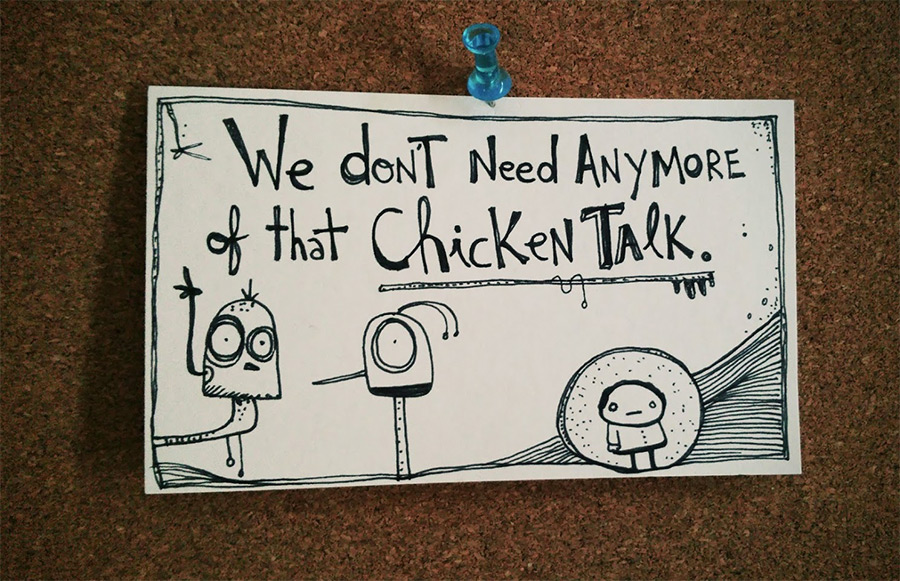If you’re afraid your presentation’s message is inherently dull, you’re not alone. We’ve been spreading the word on standing out and being bold for quite some time, but now you have no more excuses. When we came across this guy and his cartoon sidekicks, we knew we had to interview him to find out what presentation tips he had for you to save your message from boredom!
Meet Steve Klinetobe, mastermind behind The Cartoon Agency; where they help clients tell stories with big-eyed funnies.
Steve, on your website you list your strategic approach to “coming up with this stuff,” but what is your approach to turning a seemingly dull topic into something entertaining?
Ah, you’ve uncovered the scrubby itch that bothers all professionals—the topics are inherently lame. But this is a challenge I’ve always been hungry for. In fact, some of the most exciting campaigns I’ve ever worked on were for really, really boring products (90% recycled copy paper, sexy boy).
In some ways, boring topics are easier because the unexpected is so….unexpected. Here are some presentation tips:
- Know the industry from every angle. You can’t break the rules if you don’t know the rules.
- Every industry has a dark side, meaning there is always a thread of self-deprecation, gallows humor, and sweet bitterness. Discover this and you’ve got gold.
- Don’t forget every industry, every vertical, every organization is filled with real-live human people persons. Emotion drives humor and authenticity.
Those are great tips! This question’s a bit more personal… we talk to a lot of people who get stuck in a run coming up with the right way to tell their story. The proverbial brain fart. When your creative muse isn’t there, and you have to keep grinding, what do you do?
My muse is a ratty old squirrel named Douglas. He’s almost always drunk and surly. To be honest, I try to avoid him at all costs.
Instead I rely heavily on my trusted buddies. Writers, cartoonists and marketing pros that are willing to talk it through. Sometimes the process is painful and I have to buy them shiny things, but it always works.
This is an old creative director’s cliché but it is still useful: Ask yourself, “What is the idea behind the idea?” Keep doing this until you find the core.
That’s a great way to dig deeper into your topic. Also, Douglas has recently spent some time next door at Ed Debevics, which is now a leveled plot of land where I’m sure he used to work. What advice would you give an organization trying to stand out with a resonating message?
Don’t be afraid. Don’t be a robot. Don’t be boring.
We’re standing uncomfortably in a flood of content. So much dribble drabble, so much to wade through. Why would you want to add more to that noise?
I’m not all suggesting you ignore the tenets of marketing, i.e. messaging, but you don’t have to build a message that looks, acts and smells like everyone else’s. The whole point is to get noticed, so get noticed.
Sometimes it’s as simple as interrupting your usual messaging with a small speed bump.
Something that reaches out and pokes your audience in the eyeball.
Cartoons are one such speed bump, so is a photo of David Hasseloff wearing a furry robe, sipping an Appletini.
It will take some time to get that out of my mind. Thank you for that. At what point did you realize cartoons were going to be the agency’s differentiator? How did you maximize the opportunity and make it a sustainable business?
Previously, I was part-owner of a large content marketing agency. We had too many specialities, too many people and not enough focus.
This time around I knew I wanted to keep the agency small and niche-y. I struggled with the concept as I was trying to narrow it down to something particular. One day, my good friend said, “Why don’t you just do what you do everyday? Draw cartoons.” That was the eureka moment.
From there it was insanely difficult and horribly painful. Eventually, the message was easy: Cartoons get noticed. But since it was such a new concept, it took awhile to educate and gain acceptance.
Also, I hired a sorcerer who had a goat.
We know a think or two about goats around here. Ask Derek if you want to know more. More importantly, we believe presentations are an art form. How can your cartoons enhance or add value to a presentation?
Most presentations are where fun goes to shrivel and die. I totally agree it’s an art form. It’s a story and nothing is as good at telling a story as cartoons. Relatable characters bring the narrative home to the audience.
One of our specialties is helping companies engage their employees. Presentations with meandering mission statements and stock-imagery aren’t enough to inspire and move a culture.
Cartoons, with their big-eyes and open hearts, are human. Universally real.
Now the biggie… Who would win in an arm wrestling competition: Elon Musk v.s. Richard Branson? Spiderman v.s. Batman?
Musk would beat Branson. Why? Musk is power-packed with the essence of space-lions.
Spiderman and Batman would be locked in match that would last an eternity. In fact, it would last so long they would merge as one and become a super-villain named Skiddy.
[x_author title=”Who’s this genius we interviewed?”]





0 Comments